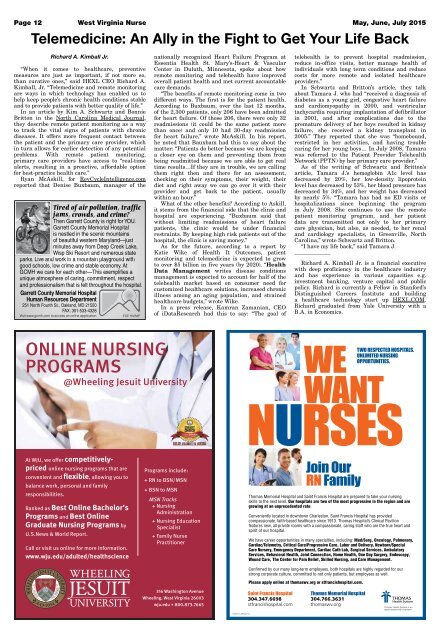West Virginia Nurse - May 2015
Create successful ePaper yourself
Turn your PDF publications into a flip-book with our unique Google optimized e-Paper software.
Page 12 <strong>West</strong> <strong>Virginia</strong> <strong>Nurse</strong> <strong>May</strong>, June, July <strong>2015</strong><br />
Telemedicine: An Ally in the Fight to Get Your Life Back<br />
Richard A. Kimball Jr.<br />
“When it comes to healthcare, preventive<br />
measures are just as important, if not more so,<br />
than curative ones,” said HEXL CEO Richard A.<br />
Kimball, Jr. “Telemedicine and remote monitoring<br />
are ways in which technology has enabled us to<br />
help keep people’s chronic health conditions stable<br />
and to provide patients with better quality of life.”<br />
In an article by Kim A. Schwartz and Bonnie<br />
Britton in the North Carolina Medical Journal,<br />
they describe remote patient monitoring as a way<br />
to track the vital signs of patients with chronic<br />
diseases. It offers more frequent contact between<br />
the patient and the primary care provider, which<br />
in turn allows for earlier detection of any potential<br />
problems. With remote patient monitoring,<br />
primary care providers have access to “real-time<br />
alerts, resulting in a proactive, affordable option<br />
for best-practice health care.”<br />
Ryan McAskill, for RevCycleIntelligence.com<br />
reported that Denise Buxbaum, manager of the<br />
nationally recognized Heart Failure Program at<br />
Essentia Health St. Mary’s-Heart & Vascular<br />
Center in Duluth, Minnesota, spoke about how<br />
remote monitoring and telehealth have improved<br />
overall patient health and met current accountable<br />
care demands.<br />
“The benefits of remote monitoring come in two<br />
different ways. The first is for the patient health.<br />
According to Buxbaum, over the last 12 months,<br />
of the 2,300 patients, only 206 have been admitted<br />
for heart failure. Of those 206, there were only 32<br />
readmissions (it could be the same patient more<br />
than once) and only 10 had 30-day readmission<br />
for heart failure,” wrote McAskill. In his report,<br />
he noted that Bauxbam had this to say about the<br />
matter: “Patients do better because we are keeping<br />
a closer eye on them and preventing them from<br />
being readmitted because we are able to get real<br />
time results…If they are in trouble, we are calling<br />
them right then and there for an assessment,<br />
checking on their symptoms, their weight, their<br />
diet and right away we can go over it with their<br />
provider and get back to the patient, usually<br />
within an hour.”<br />
What of the other benefits? According to Askill,<br />
it stems from the financial side that the clinic and<br />
hospital are experiencing. “Buxbaum said that<br />
without limiting readmissions of heart failure<br />
patients, the clinic would be under financial<br />
restraints. By keeping high risk patients out of the<br />
hospital, the clinic is saving money.”<br />
As for the future, according to a report by<br />
Katie Wike of Health It Outcomes, patient<br />
monitoring and telemedicine is expected to grow<br />
to over $5 billion in five years (by 2020). “Health<br />
Data Management writes disease conditions<br />
management is expected to account for half of the<br />
telehealth market based on consumer need for<br />
customized healthcare solutions, increased chronic<br />
illness among an aging population, and strained<br />
healthcare budgets,” wrote Wike.<br />
In a press release, Kamran Zamanian, CEO<br />
of iDataResearch had this to say: “The goal of<br />
telehealth is to prevent hospital readmission,<br />
reduce in-office visits, better manage health of<br />
individuals with long term conditions and reduce<br />
costs for more remote and isolated healthcare<br />
providers.”<br />
In Schwartz and Britton’s article, they talk<br />
about Tamara J. who had “received a diagnosis of<br />
diabetes as a young girl, congestive heart failure<br />
and cardiomyopathy in 2000, and ventricular<br />
tachycardia requiring implantation of defibrillator<br />
in 2001, and after complications due to the<br />
premature delivery of her boys resulted in kidney<br />
failure, she received a kidney transplant in<br />
2005.” They reported that she was “homebound,<br />
restricted in her activities, and having trouble<br />
caring for her young boys… In July 2008, Tamara<br />
was referred to the Patient Provider Telehealth<br />
Network (PPTN) by her primary care provider.”<br />
As of the writing of Schwartz and Britton’s<br />
article, Tamara J.’s hemoglobin A1c level has<br />
decreased by 20%, her low-density lipoprotein<br />
level has decreased by 53%, her blood pressure has<br />
decreased by 34%, and her weight has decreased<br />
by nearly 5%. “Tamara has had no ED visits or<br />
hospitalizations since beginning the program<br />
in July 2008. She continues to use the remote<br />
patient monitoring program, and her patient<br />
data are transmitted not only to her primary<br />
care physician, but also, as needed, to her renal<br />
and cardiology specialists, in Greenville, North<br />
Carolina,” wrote Schwartz and Britton.<br />
“I have my life back,” said Tamara J.<br />
_____________<br />
Richard A. Kimball Jr. is a financial executive<br />
with deep proficiency in the healthcare industry<br />
and has experience in various capacities e.g.<br />
investment banking, venture capital and public<br />
policy. Richard is currently a Fellow in Stanford’s<br />
Distinguished Careers Institute and building<br />
a healthcare technology start up HEXL.COM.<br />
Richard graduated from Yale University with a<br />
B.A. in Economics.

















